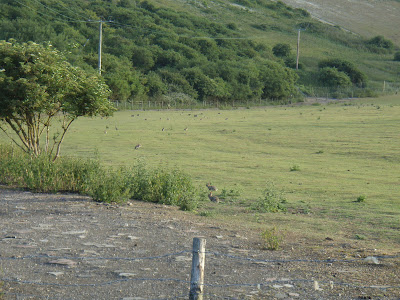Generally,british bigcats are oppurtunist hunters.Their diet changes as the seasons unfold.From late febuary it,s likely young rabbits feature almost exclusively in their diet.At this time of year every doe rabbit is popping out youngsters and she will even conceive again while lactating having 3 to 4 litters a year.Sussex is famous for holding huge numbers of rabbits,something which may explain why the county also supports a thriving bigcat population.It can,t be understated the importance of rabbits to predators like buzzards,stoats,foxes etc and its just as likely they are to cats as well.Rabbits,or the lack of them, could explain why bigcat sightings were minimal in the late "50,s to "70,s only increasing in the mid "80,s and "90,s.1953 saw the man-introduced,dreadful disease,myxymotosis arrive into this country and rabbits were devastated to less than 0.1% of their previous numbers.Even in the 1970,s there were,nt that many about and it wasn,t until the mid 1980,s that decent numbers could be seen again.I think it,s no coincidence that bigcat sightings have increased in step with the recovery of other rabbit predators like stoats and buzzards with the 1990,s seeing a real sightings boom.As spring progresses bird chicks take on an increasing role,as the grass and crops grow rabbits are that little bit harder to catch and as their numbers increase so it,s harder to surprise individuals.Once may arrives,rookerys drop numbers of fledgings onto the ground and annual sightings of bigcats at rookeries support this theory.Late. may and june are roe deer fawn birthing times and i,ve noticed fawnless does in bigcat areas,of course they take adults as well but they are not as easy to catch .Incidentely,the Great Storm of 1987 benefited roe deer by opening up woods leading to a spurt of secondary growth which roe feed on and their numbers have also multiplied since then. July sees a spurt of cat sightings in places not seen at other times of year and it,s thought they,re on the move to fresh hunting grounds,some could be on their way to meet the mass influx of gamebird poults arriving at shoots around now.Sussex woodlands support nigh on a million pheasants with at least 200,000 partridges and such easy targets wouldn,t be missed by such an oppurtunist hunter as a bigcat however it,s doubtful they would be such wasteful killers as foxes.Autumn and although cats would be picking off what they can find,expanding field vole numbers in a dry year year with plenty of seed,a good field can hold many 100,s, and sightings of bigcats bouncing in vole fields seem to point them targeting these.Winter and the coldest months will thin out the chaff in cat numbers as availability of prey diminishes and it,s now,especially with snow on the ground ,that losses of sheep really hit the fan however the share of deer in the diet seems also to increase as does foxes,ive found fox carcases only in the winter/early spring period.Of course bigcats have other food sources and there have been numerous sightings around refuse tips but they are not necessarily scavenging but after the scavengers themselves like rats and foxes.Unbelieveably they have spotted scavenging off bird tables in peoples gardens and off the scrap plates left out for foxes,we had a sighting only this year of this happening.So in fact i could be generalising when i say cats are oppurtunist hunters when they are also pre-determined feeders as well,having learnt what,where and when could become available to them.The picture above shows a field where a recent sighting took place and the rabbit numbers are estimated to be in excess of 200 in this one field.......



No comments:
Post a Comment